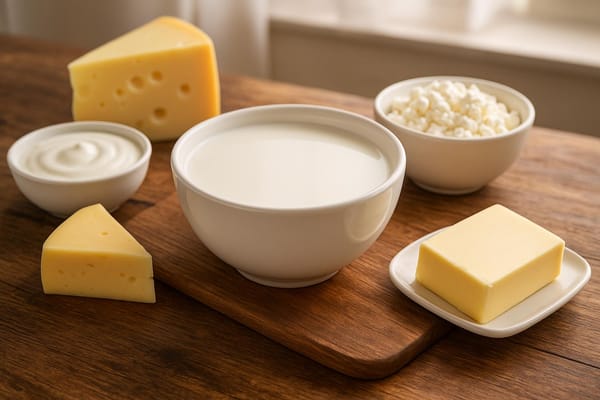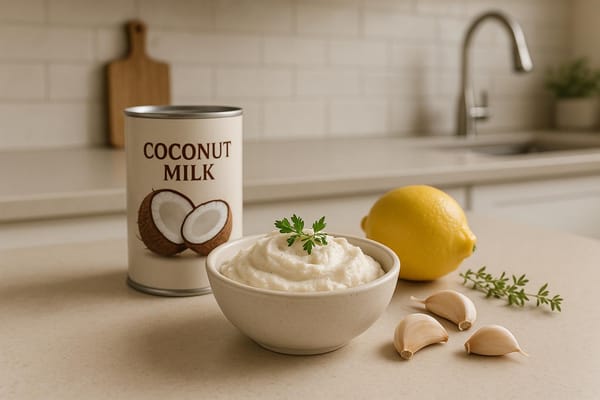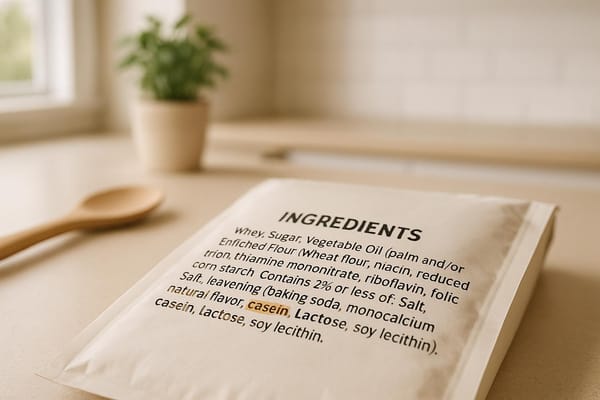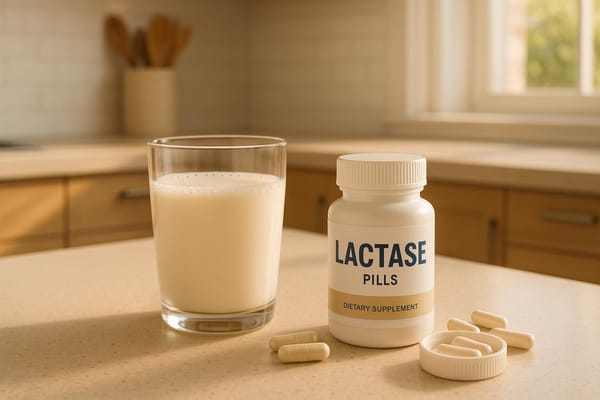8 Foods with Hidden Lactose
Lactose hides in unexpected foods, from processed meats to candies. Learn how to spot it and manage lactose intolerance effectively.
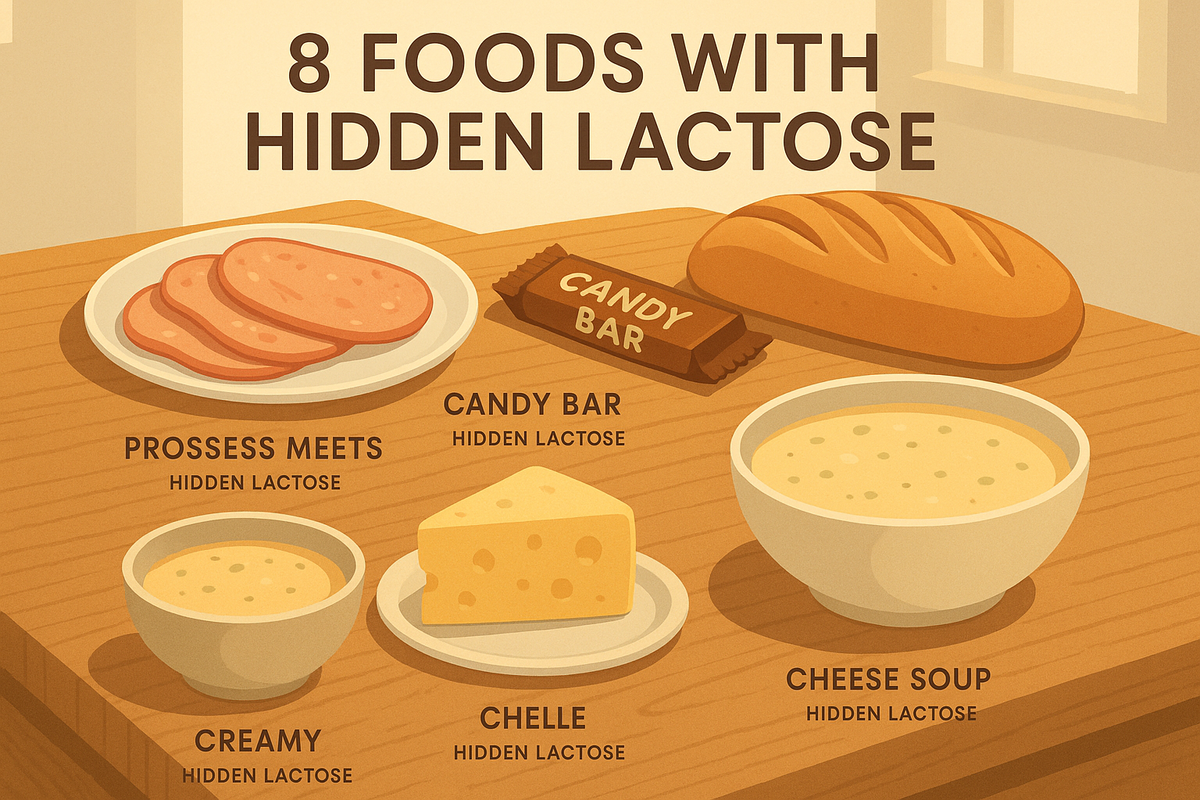
Hidden lactose is everywhere - even in foods you wouldn’t expect. For those with lactose intolerance, this can cause digestive discomfort. Here’s a quick list of surprising foods where lactose might be hiding, plus how to manage it:
- Processed meats: Look for whey or casein in fillers and binders.
- Bread and baked goods: Brioche, croissants, and even some white bread often contain milk solids or whey powder.
- Instant soups and purées: Dairy-based thickeners are common.
- Packaged meals: Creamy sauces, seasoned rice, and breaded items may include milk derivatives.
- Cereals and snack bars: Milk powder and whey protein are frequently added.
- Condiments and snacks: Salad dressings, dips, and flavored chips often use dairy-based stabilizers.
- Candy and chocolate: Milk solids, butter oil, and whey powder are standard ingredients.
- Pills and supplements: Lactose is often used as a binder in medications.
How to manage: Always check labels for terms like "whey", "casein", or "milk solids." For accidental lactose consumption, lactase enzyme supplements can help break down dairy components. Look for products labeled "dairy-free" or "vegan" for safer options.
How to find HIDDEN DAIRY in ingredients! | Not Only Carrots ...
Understanding Hidden Lactose
Hidden lactose shows up in foods you might not expect because manufacturers use dairy-based ingredients to improve texture, flavor, or shelf life.
What Does "Hidden" Lactose Mean?
Hidden lactose refers to dairy ingredients that aren’t obvious on food labels but can still cause issues for people with lactose intolerance.
Dairy Ingredients to Watch For
Here’s a quick guide to common dairy-derived ingredients often found on U.S. food labels:
| Ingredient Type | Examples to Look For |
|---|---|
| Milk Derivatives | Whey, Casein, Milk solids, Milk protein isolate |
| Cream-Based | Sweet cream, Cream powder, Modified cream |
| Butter Components | Butter oil, Butter fat, Artificial butter flavor |
| Processing Aids | Lactoglobulin, Lactalbumin, Lactose monohydrate |
| Protein Additives | Milk protein concentrate, Caseinate, Whey protein |
How It Affects Digestion
For those with lactose intolerance, hidden lactose can lead to digestive problems because their bodies don’t produce enough lactase to process it.
Role of Enzyme Supplements
Lactase is the enzyme the body uses to break down lactose. Enzyme supplements, which often include lactase along with protease and lipase, can help improve dairy digestion for those who are sensitive.
In the next section, we’ll explore specific food categories where hidden lactose is commonly found.
1. Processed Meats
Processed meats can sometimes contain lactose hidden in dairy-based additives. Always read ingredient labels carefully to avoid surprises. Look out for terms like whey powder, milk proteins, and caseinates, which are often used as fillers or binders. Up next, we'll look at another everyday food source where lactose might be hiding.
2. Bread and Baked Products
Dairy can often sneak into bread and baked goods in ways you might not expect. Many manufacturers use dairy-based ingredients like dough conditioners to enhance texture.
Here are some common examples:
- Brioche: Typically made with butter and milk.
- Hot dog and hamburger buns: May include whey or milk powder.
- Bagels: Often contain milk powder.
- Croissants: Include butter and sometimes milk powder.
- Packaged white bread: Might have milk solids or whey protein.
When checking labels, keep an eye out for terms like milk solids, whey powder, nonfat milk powder, casein, or modified milk ingredients. These all indicate the presence of dairy.
For dairy-free options, go for traditional sourdough, which is usually made with just flour, water, and salt. If you’re sensitive to lactose but still want to enjoy bread with dairy, consider taking a lactase pill, like milktab, about 15–30 minutes before eating.
3. Instant Soups and Purées
Instant soups and purées often sneak in dairy ingredients like milk-based thickeners or additives to enhance creaminess and flavor. Even items that seem dairy-free, such as vegetable bisques or instant noodles, may contain these hidden ingredients, which can easily catch shoppers off guard.
To avoid discomfort, always check ingredient labels carefully. If you’re unsure, taking a milktab lactase supplement 15–30 minutes before eating can help. Milktab combines lactase with protease and lipase enzymes, making it effective at breaking down dairy components.
For peace of mind, stick to products labeled as dairy-free or vegan to steer clear of hidden lactose.
4. Packaged Meals
Packaged meals often hide lactose in their ingredient lists, a pattern similar to other processed foods. Reading labels carefully is essential when selecting these products.
Here are some common lactose-containing ingredients to watch out for:
- Whey powder: Often added for protein and flavor.
- Caseinates: Used as emulsifiers.
- Modified milk ingredients: Serve as binding agents.
- Milk solids: Contribute to texture.
Certain types of packaged meals call for extra attention. For example, frozen stir-fries and vegetable-based dishes may include sauces thickened with milk derivatives or marinades that use dairy to tenderize meat.
Be cautious with these meal categories:
- Creamy pasta dishes: Often use milk powder in sauces.
- Seasoned rice bowls: May contain dairy-based flavor enhancers.
- "Butter flavored" items: Frequently include dairy components.
- Breaded products: Coatings can contain milk proteins.
To steer clear of dairy, always check for terms like "milk derivatives", "dairy protein", or "milk solids" on ingredient lists. If you're unsure, taking a lactase supplement such as milktab 15-30 minutes before eating can help. For added assurance, look for products labeled as "dairy-free" or "vegan."
5. Cereals and Snack Bars
Breakfast cereals and snack bars often contain dairy-based ingredients that can be unexpected for those avoiding lactose. Manufacturers frequently use milk derivatives to improve texture or enhance nutritional value, making it crucial to carefully read labels before purchasing.
Common dairy ingredients in these products include:
- Milk powder: Adds nutritional value
- Whey protein: Improves texture
- Casein derivatives: Acts as a binding agent
- Milk solids: Enhances flavor
Here’s a quick breakdown of dairy components often found in cereals and snack bars:
| Ingredient | Common Forms | Purpose |
|---|---|---|
| Whey | Concentrate, Isolate | Protein source |
| Milk Powder | Full-fat, Skim | Improves texture |
| Caseinates | Calcium caseinate, Sodium caseinate | Acts as a binder |
| Milk Solids | Regular, Modified | Boosts flavor |
When shopping, keep an eye out for these label warnings:
- "Contains milk ingredients"
- "May contain traces of milk"
- "Manufactured in a facility that processes milk"
If you're lactose intolerant, consider taking a lactase supplement like milktab 15–30 minutes before consuming these products. Additionally, many brands now offer dairy-free options, making it easier to find alternatives that suit your needs.
6. Condiments and Snacks
Condiments and snacks often hide dairy ingredients, catching many lactose-intolerant people off guard. These ingredients are used as stabilizers, thickeners, or flavor enhancers and can easily go unnoticed.
Watch out for dairy in these condiments:
- Ranch and creamy salad dressings
- Mayonnaise-based spreads
- Cheese-flavored sauces
- Creamy dips and spreads
Snacks can also be tricky, especially flavored options. Many chips, crackers, and savory treats include milk-derived ingredients in their seasoning blends.
| Product Type | Hidden Dairy Ingredients |
|---|---|
| Salad Dressings | Buttermilk, cream, milk solids |
| Dips | Whey powder, modified milk ingredients |
| Flavored Chips | Milk derivatives, cheese powder |
| Seasoned Snacks | Casein, lactose powder |
These clues can help you spot dairy in your favorite condiments and snacks. If you're worried about accidental exposure, consider taking milktab 15–30 minutes before eating. One satisfied user, Juana, shared her experience:
"Milktabs WORK!! I went on a European vacation and ate all the cheeses I wanted to! It was so great to have these tabs!!!!"
For added protection, keep these Label Reading Tips in mind:
- Look for terms like "modified milk ingredients" and "milk solids"
- Check for whey or casein derivatives
Even "non-dairy" products can sometimes sneak in milk-based ingredients. A comprehensive enzyme supplement with lactase, protease, and lipase can help you digest dairy more comfortably.
7. Candy and Chocolate
Candy and chocolate often contain milk-based ingredients that can add hidden lactose. The table below highlights some common dairy ingredients to watch for.
Milk-based ingredients commonly found in candy and chocolate:
| Ingredient Type | Examples |
|---|---|
| Milk Solids | Dry whole milk, nonfat milk powder, milk protein concentrate |
| Milk Fats | Butter oil, cream, milk fat |
| Milk Derivatives | Whey powder, casein, lactose |
| Flavorings | Milk chocolate coating, caramel |
Carefully check ingredient lists and allergen statements for these milk-derived ingredients. If you're sensitive to lactose, consider taking a lactase supplement like milktab before enjoying these treats. Its triple-enzyme formula can help break down dairy, making it easier to enjoy your favorite sweets.
Quick tip: Always double-check the allergen statement on candy and chocolate packaging to ensure they align with your dietary requirements.
8. Pills and Supplements
Did you know that many medications and supplements include lactose as an inactive filler? Pharmaceutical companies often use lactose as a binder in pill formulations, which can be a concern if you're lactose intolerant.
Medications That May Contain Lactose
| Medication Type | Examples Where Lactose May Be Found |
|---|---|
| Pain Relievers | Generic acetaminophen and ibuprofen tablets |
| Prescription Drugs | Birth control pills and antacids |
| Supplements | Vitamin D capsules and calcium tablets |
| Over-the-Counter Products | Gas relief tablets and allergy medications |
To avoid unintended lactose exposure, always review ingredient lists carefully. Look for terms like lactose monohydrate or milk sugar.
Tips for Managing Lactose in Medications
- Check the label: Search for lactose-related ingredients in the inactive list.
- Ask your pharmacist or doctor: Request lactose-free alternatives when possible.
- Use lactase enzyme supplements: Taking a lactase supplement before consuming products with lactose can help.
For example, a lactase supplement like milktab can be taken 15–30 minutes before using medications or supplements containing lactose. Its triple-enzyme formula (27,000 FCC units of lactase, 22,000 FCC units of protease, and 1,000 FCC units of lipase) helps break down hidden lactose, making it easier to digest.
When receiving new prescriptions, inform your healthcare provider about your lactose intolerance. Many medications have lactose-free options available.
"Milktab works great! Most lactose pills don't work for me, super happy I bought these pills." - James
Reading Labels for Hidden Lactose
Food labels are required by the FDA to list major allergens like milk, making it easier to spot hidden sources of lactose.
Common Label Terms to Watch For
| Label Term | Contains Lactose | Usually Found In |
|---|---|---|
| Whey | Yes | Protein bars, baked goods |
| Casein/Caseinate | Yes | Processed meats, snacks |
| Milk Solids | Yes | Instant soups, sauces |
| Dry Milk Powder | Yes | Baked goods, cereals |
| Modified Milk Ingredients | Yes | Processed foods |
Understanding FDA Allergen Labels
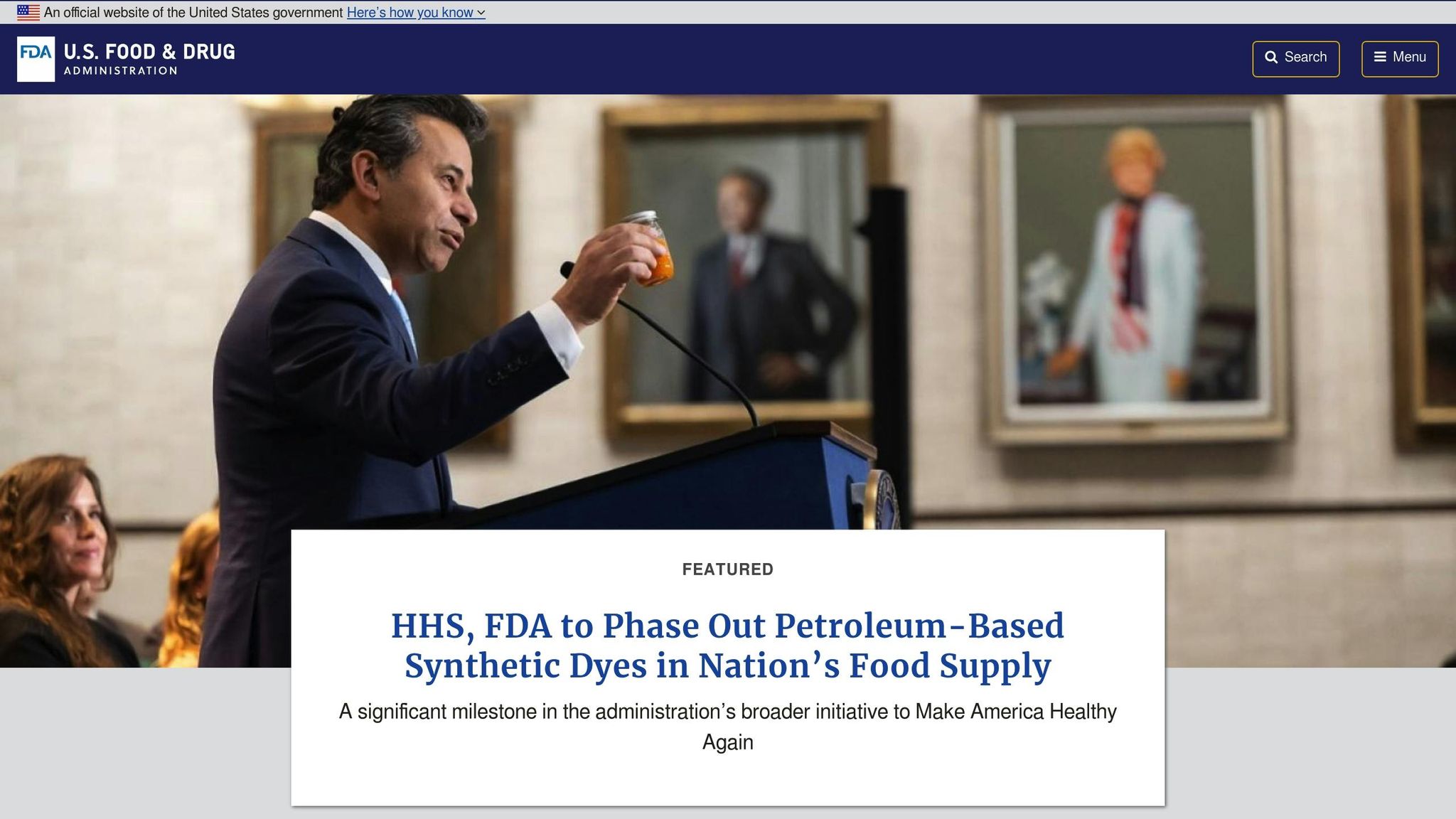
The Food Allergen Labeling and Consumer Protection Act (FALCPA) ensures that milk-based ingredients are clearly listed on product labels. Use this information to carefully review ingredient lists and avoid unexpected sources of lactose.
Smart Shopping Strategies
When shopping, check both the ingredient list and allergen declarations for milk-derived terms like whey, casein, milk solids, and dry milk powder. These ingredients often hide in processed foods, so a close look is key.
Restaurant Dining Tips
Apply these same principles when eating out. Ask about the preparation of dishes, especially sauces, dressings, and marinades. If you’re lactose intolerant, let the staff know so they can recommend dishes free from hidden dairy ingredients.
Using Lactase Supplements
Lactase supplements can be a helpful way to handle unexpected dairy in your diet. Products like milktab offer a blend of three enzymes designed to break down dairy components efficiently.
Understanding Triple-Enzyme Formulation
| Enzyme Type | Amount (FCC Units) | Function |
|---|---|---|
| Lactase | 27,000 | Breaks down lactose (milk sugar) |
| Protease | 22,000 | Digests milk proteins |
| Lipase | 1,000 | Helps process dairy fats |
These enzymes work together to make it easier for your body to digest dairy products.
How to Use Lactase Supplements
For the best results, follow these steps when consuming foods with hidden lactose:
- Take the supplement immediately before eating dairy-containing foods.
- Stick to the recommended limit of 2 pills per day.
This straightforward approach enhances your ability to enjoy dairy without discomfort.
What to Look for in a Quality Product
Choose lactase supplements that meet these standards:
- Verified potency through third-party testing
- Certified vegan and non-GMO
- FODMAP-free for sensitive stomachs
- Convenient, portable packaging
"Milktabs WORK!! I went on a European vacation and ate all the cheeses I wanted to! It was so great to have these tabs!!!!" - Juana
Practical Benefits of Lactase Supplements
Lactase supplements like milktab have proven their value in real-life situations. Their small, travel-friendly packaging makes them easy to carry, and their enzyme blend provides reliable support for digesting hidden lactose in various foods.
Conclusion
Hidden lactose in everyday foods can make life tricky for those with lactose intolerance. Dairy ingredients often show up in unexpected products - like processed meats or supplements - so checking labels carefully is key.
Enzyme supplements can be a helpful tool. A mix of enzymes like lactase, protease, and lipase can break down dairy components, making digestion smoother and minimizing discomfort. Look for enzyme supplements that have been tested by third parties to ensure they work effectively.
Dealing with lactose intolerance doesn’t mean cutting out all dairy. By staying alert to hidden lactose and using the right enzyme support, you can still enjoy a wide range of foods. Whether you’re at a restaurant, traveling, or shopping, knowing what to watch for and having dependable digestive help makes food choices much easier.
FAQs
What are the common signs of lactose intolerance after eating foods with hidden lactose?
Lactose intolerance symptoms can appear within a few hours after consuming foods that contain hidden lactose. Common signs include bloating, gas, stomach cramps, diarrhea, and sometimes nausea. These symptoms occur because the body struggles to digest lactose properly.
If you frequently experience these symptoms after eating, it may help to check ingredient labels carefully or consider solutions like lactase supplements to manage your lactose intake more effectively.
How can I spot hidden sources of lactose on food labels?
To find hidden lactose in food labels, check for ingredients that may contain lactose even if it's not directly listed. Common terms to look for include whey, milk solids, milk by-products, and casein. Be cautious of processed foods, as ingredients like modified food starch or natural flavors can sometimes contain lactose.
If you often feel discomfort after consuming dairy, it might be due to low levels of digestive enzymes like lactase, which help break down lactose. Understanding labels and knowing what to avoid can make managing lactose intolerance much easier.
What are some tips for avoiding hidden lactose when dining out at restaurants?
Avoiding hidden lactose at restaurants can be tricky, but a few simple strategies can help. Start by asking your server about ingredients in dishes and whether dairy is used in preparation. Be specific by mentioning items like butter, cream, or cheese, which may not always be obvious in menu descriptions.
Opt for dishes that are less likely to contain dairy, such as grilled meats, salads (without creamy dressings), or vegetable-based options. If you're unsure about a dish, don’t hesitate to request modifications, like leaving off cheese or substituting non-dairy ingredients.
For extra peace of mind, consider using a dietary supplement like Milktab, which contains a high-potency blend of lactase and other enzymes to help break down lactose. This can make dining out more enjoyable without worrying about hidden dairy ingredients.
